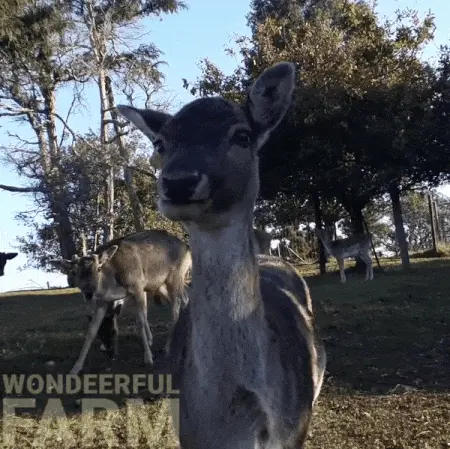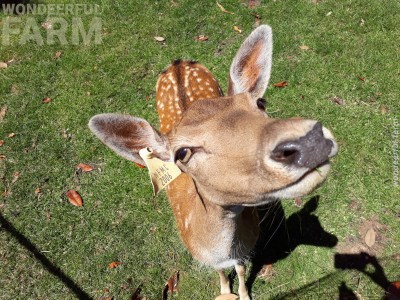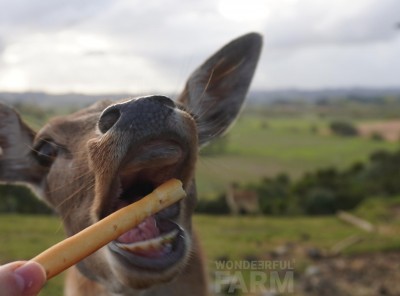Do Deer Chew Cud? Deer Digestive System.
» Deer stories » Deer facts » Do Deer Chew Cud? Deer Digestive System.Have you wondered why do deer chew all the time? You've come to the right place. In this post, we're cover this intriguing question and more.
“Chew your food well”, “don't gobble” - said moms all over the world. Most mothers tell children not to “gobble” their food.
Well, not deer moms. They must tell their fawns the exact opposite.
“Gobble it up!”
“Just swallow it, there'll be plenty of time to chew it over!”
Because that's what deer do when they find food, especially when there's competition around - they stuff their mouths as full of it as possible, as fast as they can.
In this educational / entertainment post:
- Deer chewing cud (video)
- Deer's Digestive System
- How Many Stomachs Does a Deer Have?
- Ruminant Feeding Types
The funniest thing is that you can actually see it go down their throats.
Watch Junkie on this funny gif below [might have to give it some time to fully load or disable your ad-blocker]:

So you can see food go down their throats...
But did you know - eeew warning - that deer regurgitated and chewed their cud again? Well, now you do. Deer use some parts of their 4-chambered stomach to gather a lot of food at once and then sit down and ruminate it later.
In the following 30 seconds video you can easily notice that the doe sits down having nothing in her mouth only to 'send up' some cud and start chewing it.
Here's another video of cud chewing, this time featuring Blackie:
Such is deer life. Another day, another chew. Very chill. Almost zen, eh?)
But appearances can be deceiving, even peaceful looking deer can push around, bite and attack each other. But we'll save that for a whole new story.
Meanwhile, if you're curious about deer, you might want to check out our deer facts post and then maybe take a quiz?
Deer Digestive System
Mammals that eat a lot of grass, or other relatively low-quality vegetation, have to process their food thoroughly to extract the maximum amount of nutrition. This is achieved by fermenting it in a specialized stomach prior to digestion.
For this reason, ruminant stomachs have 4 chambers: the rumen, the reticulum, the omasum and the abomasum.

image: depositphotos

image primary source: unknown
Deer, elk and moose all ruminate. Ruminants also include cattle, sheep, goats, buffalo, giraffes and camels.
- The rumen, also known as a paunch, is the largest section that is basically storage, allowing for the deer to gather a lot of food at once to be digested later. The process of chewing cud is called rumination. Hence the name - ruminants.
- The reticulum is the second stomach chamber where helpful microorganisms cause fermentation.
The reticulum will ball up the portion of food sent to it by the rumen, mixing it with some microorganisms, and trigger the regurgitation of the cud.According to some sources: For deer, the cud is about the size of a large lemon. A white-tailed deer chews its cud an average of 40 times while mule deer average 56 chews.
Digestion in deer's second stomach alone takes roughly 16 hours.
- When the cud moves to the third chamber (omasum) - water is absorbed.
- Next, the food enters the abomasum, the last chamber, also called the true stomach. This is where gastric juices carry on digestion.
- And finally, in the intestines, the food is absorbed by the animal’s body, providing the needed nutrients.
So How Many Stomachs Does a Deer Have?
While deer do have multiple stomach compartments (listed above), they are all parts of their stomach system and work together in a coordinated manner to digest their food. This is a single stomach, consisting of multiple sections, rather than multiple stomach organs. So one. Deer have one stomach only.
Understandably, there's a bit of confusion on the topic and it's common to see people mentioning that deer or cows have four stomachs. However, it's not correct to refer to them as having multiple independent stomachs; instead, they have one stomach divided into several functional sections.
Human heart is a multi-chambered organ. Chambers of a human heart work together to pump blood and together make up a single organ.
Fun facts. Sort of.
Imagine this. A deer urinates and defecates on average of about 13 times a day.
Since digestion also produces heat, rumen acts as a furnace in winter, helping to keep the animals warm.
Ruminant Feeding Types
Based on the diets they prefer, ruminants can be classified into distinct feeding types:
- concentrate selectors
- grass/roughage eaters
- intermediate types
Concentrate selectors prefer to browse trees and shrubs. Deer and giraffes are examples of these. Animals in this group of ruminants prefer plants and plant parts high in easily digestible, nutrient dense substances such as plant starch, protein, and fat. They are limited in their ability to digest the fibers and cellulose in plant cell walls. That's why deer prefer legumes over grasses. [ source ]
The relative sizes of various digestive system organs differ by ruminant feeding type.
So the way a cow's rumen is built is a bit different to the way a deer's rumen is.
For those interested in learning more about deer digestive system here are some links:
Quick fact: About 150 different types of animals have multiple compartments in their stomachs, including cows, sheep, camels, yaks, deer and giraffes.
So the next time someone wonders "why do deer chew all the time" - you can give them the answer.
We hope this post was both educational and amusing for you, and covered the topic of deers perpetual chewing. If you'd like to test your knowledge of deer biology and behavior take our deer quiz.
Last modified 2023-09-08 at 23:01
Published 21 May 2020

Wondeerful Farm
Haha yes, that's very visible on their long thin necks. :)
Add your comment
More «Deer facts» stories
Fun and scary facts about deer
Interesting facts about deer. True stories. Deer antlers are the fastest growing tissue on Earth! They can grow at a rate of ¼ inch (0.6 cm) per day!
read more...
Fallow Deer (Dama Dama)
Facts about fallow deer species. Fallow deer distribution, appearance, lifestyle and lifespan.
read more...
Inside A Deer's Mouth. Deer Teeth.
Do deer have upper teeth? How does deer mouth look on the inside? Deer have baby teeth, just like people do...
read more...
 '
'



Ramhorn 15-06-2025:
We live in a wooded mountainous region. I didn't realize that White Tailed Deer "chew the cud", until a saw a doe, laying on our land and burping up food to chew on it. I could see the lump traveling up her neck and into her mouth.